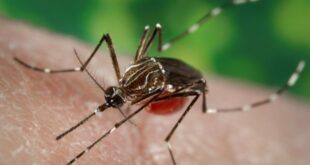Heat and humidity can be a dangerous mix and climate change will likely bring more of both.

A pig grunts and leans into a back scratch from Charlotte Wasylik on her second-generation family farm near Vermilion, Alta. When it’s hot, the pigs cake themselves in the mud to cool down and block the sun, but Wasylik said sweltering days are rare on Chatsworth Farm — at least for now.
As human-caused climate change cranks up the heat in Canada, it’s also likely to lead to more humid days, changing life and posing a threat in regions that aren’t adapted to muggy summer weather.
Projections show parts of British Columbia and Alberta, where people are used to dry heat, could see a significant rise in days with humid, sticky weather.
Vermilion, for instance, typically saw around one day a year between 1981 and 2010 where the humidex climbed above 35 (humidex is how hot it feels when temperature and humidity combine).
The latest humidex projections from Environment and Climate Change Canada (ECCC) show that if the world cuts greenhouse gas emissions and reaches net zero by 2050, the increase in high humidex days could be limited to just five days a year by the end of the century.
But if the world continues to develop a fossil-fuel based economy, high humidex days in Vermilion could jump to as many as 34 a year by the end of the century.

Wasylik said that many hot and humid days would make farm life in central Alberta more difficult — whether it’s haying, repairing a fence or caring for livestock. Even the breed of cattle they have, Bos taurus, was bred for cooler temperatures.
“It just makes every work aspect a little bit more challenging and you can’t work for as long or you don’t really want to because it’s hard on you,” Wasylik said.
A few days ago, Wasylik, 25, was clearing thistles from the yard on a day where the humidex reached 32 — not considered dangerous under ECCC’s general guidelines.
“I worked for close to an hour. By the end I was just exhausted. It was really hot, hot work.”
She said the next generation will have to find ways to adapt to new extremes because chores often can’t wait for the weather to improve.
Not just uncomfortable, but dangerous
While humidex — like wind chill — is a familiar way of measuring what the temperature actually feels like to people in central and eastern Canada, it’s a more foreign concept in the West.
“The further west you go in in the country, you generally don’t have as much of an input of humidity,” said Armel Castellan, a Victoria-based warning preparedness meteorologist with ECCC.
“It’s definitely there to a certain extent because we can’t live in an environment that has no humidity, but it’s … less of an overall part of the equation.”
Humidity adds another layer of danger to heat because when there’s too much moisture in the air, sweat doesn’t evaporate as easily, making it harder to cool off.
Everyone experiences heat differently, which means hot and humid conditions are riskier for some people, especially seniors and those with certain underlying health issues like diabetes.
People who aren’t used to humid heat could also be especially vulnerable to new extremes, said Kenneth Chow, a climate scientist with the Canadian Centre for Climate Services at ECCC.
“It’s kind of novel to them,” he said. “If they’ve previously never experienced any [high humidex] days, going from zero to 30 days on average would be quite significant and — depending on their capacity to adapt — might strain and put a lot of people at risk.”
Even Medicine Hat, known as the sunniest city in Canada, didn’t used to see many days with high humidex. Depending on greenhouse gas emissions, it could go from around two days a year with a humidex above 35 to between 13 and 51 by the end of the century, according to ECCC’s projections.
It’s a shift already felt by locals.
“There’s been a change,” said Brian Stauth, managing director of public services for the City of Medicine Hat.
“[Humidity is] certainly not something we would have thought of as Medicine Hatters a decade ago, but we do now.”
Should heat warning criteria be updated?
Depending on greenhouse gas emissions, Edmonton could see the number of days above a humidex of 35 climb from around one a year to between four and 31 by the end of the century. Calgary could go from zero days with a high humidex to between one and 25.
British Columbia, too, could see significant change — Vancouver could go from one day a year with a high humidex to between six and 27 days.
Currently, Alberta and British Columbia are the only provinces that don’t trigger heat warnings based on humidex.
“That’s just something they’ve never experienced — or don’t usually experience,” Chow said.
There’s also no humidex trigger for heat warnings in the Northwest Territories, Yukon and Nunavut, but projections show those regions are not likely to see many days over a 35 humidex within the coming decades.
Castellan said that criteria for the heat warning program will continue to be revisited to adapt to climate change.
“In some ways, humidity might be a role that increases in the West, but we may still want to mostly forecast from a temperature point of view,” he said, adding that even if it gets more humid, the West will likely remain relatively drier than Eastern Canada.
How 1 city is preparing for a muggy, sticky future
Rather than wait for other levels of government to adapt to new normals, the city of Lethbridge in southern Alberta took matters into its own hands.
“The [heat warning] thresholds are quite high in the province. This puts us in an awkward situation where we know things are happening in the community, but we’re not meeting specific thresholds of provincially defined emergency,” said Luke Palmer, an emergency planning and risk supervisor with the City of Lethbridge.
Heat waves can be especially dangerous for seniors, low-income people and those with mental health issues. Palmer said the city wanted to make sure it’s ready to protect the most vulnerable.
That’s why Lethbridge created its own city-defined heat warning. If local officials evaluate the weather forecast and determine conditions are severe enough — be it the temperature or humidity — the city can identify a local emergency, warning citizens and opening cooling centres, even if the temperatures don’t meet provincial heat-warning criteria.
The power was created in 2022 and Lethbridge has yet to use it, but Palmer said it’s a tool in their back pocket to make sure they’re prepared.
Scott Johnson, a spokesperson for Alberta Health, said that the province is also evaluating its approach to extreme heat and humidity, “which are becoming a more regular occurrence.
The BC Centre for Disease Control is also evaluating its heat warning criteria and humidity is one of the factors being considered in the analysis.
The government of Canada, for its part, has pledged to eliminate all heat wave deaths by 2040.
ABOUT THE AUTHOR

Journalist
Jaela Bernstien is a Montreal-based journalist who covers stories about climate change and the environment for CBC News. She has a decade of experience and files regularly for web, radio and TV. She won a CAJ award as part of a team investigating black-market labour in Quebec. You can reach her at jaela.bernstien@cbc.ca
With files from Naël Shiab
*****
Credit belongs to : www.cbc.ca
 Atin Ito First Filipino Community Newspaper in Ontario
Atin Ito First Filipino Community Newspaper in Ontario






